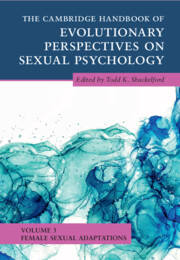Book contents
- The Cambridge Handbook of Evolutionary Perspectives on Sexual Psychology
- The Cambridge Handbook of Evolutionary Perspectives on Sexual Psychology
- Copyright page
- Contents
- Contributors
- Preface
- Part I Precopulatory Adaptations
- 1 Women’s Preferences: Precopulatory Adaptations
- 2 Female Sexual Attraction Tactics
- 3 Extra-Pair Sexual Interest
- 4 Female Intrasexual Competition
- 5 Female Intersexual Selection
- 6 Evolution of Precopulatory Defense from Rape and Coercion in Women
- 7 Mate Poaching
- Part II Copulatory Adaptations
- Part III Postcopulatory Adaptations
- Index
- References
2 - Female Sexual Attraction Tactics
from Part I - Precopulatory Adaptations
Published online by Cambridge University Press: 30 June 2022
- The Cambridge Handbook of Evolutionary Perspectives on Sexual Psychology
- The Cambridge Handbook of Evolutionary Perspectives on Sexual Psychology
- Copyright page
- Contents
- Contributors
- Preface
- Part I Precopulatory Adaptations
- 1 Women’s Preferences: Precopulatory Adaptations
- 2 Female Sexual Attraction Tactics
- 3 Extra-Pair Sexual Interest
- 4 Female Intrasexual Competition
- 5 Female Intersexual Selection
- 6 Evolution of Precopulatory Defense from Rape and Coercion in Women
- 7 Mate Poaching
- Part II Copulatory Adaptations
- Part III Postcopulatory Adaptations
- Index
- References
Summary
The historical, and perhaps still stereotypical, image of women as coy and passive in mate selection is not correct. While intrasexual competition among men has been studied extensively, theoretical and empirical work focusing on how women engage in intrasexual competition and intersexual mate choice has received less attention. More recently, there has been a growing literature which has shown that women’s intrasexual competition can be fierce, and that it is not limited to self-promotion in order to attract a partner. The evolutionary psychology theoretical aspects guiding this research are parental investment theory, sexual conflict theory, and sexual strategies theory, which we present briefly at the start of this chapter. Several individual differences, such as personality traits, sociosexuality, dark triad traits, age and mate value, influence what attraction tactics work for whom. Further, we present various tactics women use to show sexual interest, how tactics are linked to motivation for sexual intercourse, and how women’s attraction tactics work with new technology, such as dating apps. In addition, we have reviewed the literature on women’s intrasexual competition, with specific focus on how women derogate rivals, self-promotion their traits and how they use various tactics to disrupt rivals’ relationships through mate poaching.
Keywords
- Type
- Chapter
- Information
- Publisher: Cambridge University PressPrint publication year: 2022

